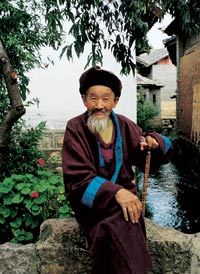
Their area of Lijiang gurgles with water, which Naxi people respect as a life-giving source: Most residences lie next to running streams. Numerous bridges traverse cobblestone streets, which are lined by traditional Ming and Qing-style homes. In these antiquated enclaves, pebbles and pieces of tile are arranged in different symbols that denote happiness or good fortune.
According to historical records, the Naxi people were closely related to an earlier tribe known as "Maoniu Yi" in the Han Dynasty (206 B.C.-220 A.D.), "Mosha Yi" in the Jin Dynasty (265-420) and "Moxie Yi" in the Tang Dynasty (618-907). Ethnologists were able to make the connection because of the striking similarities in the groups' cultural traits. The name of Naxi (also known as Nakhi or Nahi) came about in 1949, after the People's Republic of China was founded.
Naxi language reflects the tribe's ancient Tibetan-Burmese origins, where na means "black" (a color of high standing among the early tribal clans) and xi means "man." "The black clan, which the Naxi associate themselves with, was a slave-owning class. They had a higher social status. All other groups were subordinate to the black clan," explains Song Shuhua, Professor of Ethnology at the Central University for Nationalities in Beijing.
Hardy and courageous, the Naxi were excellent frontier troops for Kubla Khan's army during the Ming and early Qing dynasties. By 1723, about the time when Lijiang received its first Qing-appointed magistrate, fewer Naxi men were conscripted for military service so many turned to trade and became merchants.
Their military background came in handy: They were the first to come up with the idea of majun (horse calvary) - a system they devised to safely transport large amounts of their goods and essentials like salt and wool from one place to the next. Trade kept the community prosperous when Lijiang became an important stop on the caravan supply route from India to western China with the advent of World War II.
From the early eighteenth century, the Naxi people were increasingly influenced by Han culture. They adopted Confucian ethics, the practice of arranged marriages and Han funereal customs whereby, instead of cremating their dead, they buried them. Today, the traditional practice of cremation is practiced only by Naxi groups in Zhongdian County in Yunnan, where they also carry on the tradition of animal sacrifices before funerals, so that the animals' souls accompany the deceased to the next world.
The Naxi have long developed their own culture, which includes music, art and a writing system. The Dongba language, named after the scholarly priests who invented it, is made up of 2,200 pictographs - and is possibly the only pictographic language alive today.
As caretakers of knowledge, Dongba priests were the only ones allowed to learn, master and interpret the complex script. They chanted from these manuscripts on significant occasions: weddings, funerals, prayers and festivities.
![]() 北京市通信公司提供网络带宽
北京市通信公司提供网络带宽
